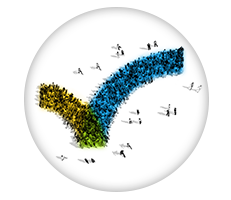How to Choose a DSP Solution for B2B Programmatic Advertising

Programmatic advertising refers to automated buying, selling and management of digital ad space, and to do that, B2B marketers must choose a DSP solution. Advertisers purchase ad space (programmatic direct) through algorithm-based real-time bidding (RTB) or auctions, and the whole process takes place within milliseconds.
(Know more about RTB and related terms here.)
A demand side platform (DSP) is software that lets advertisers -- like B2B brands -- manage engagement with multiple ad exchanges and data accounts through one platform or interface. A DSP serves ads in thousands of websites and apps automatically without manual negotiations or intervention. As more B2B leaders turn to these tactics for their revenue strategies, the interest in solid programmatic partnerships grows. It’s become a must-have for revenue teams everywhere.
A Good DSP Solution Is a Must Have!
As a B2B marketer, you want a DSP suited for your purpose and within your means and capabilities, but the options can be complicated.
Benefits of DSP Solution
Both B2B and B2C marketers find that programmatic advertising helps them reach niche audiences, escalating buyer engagement and conversion rates. B2B marketers gain multiple benefits from intent-driven programmatic advertising:
- Manage your digital advertisements through one platform, thus avoiding wasted time, insight confusion and disconnected marketing.
- Place contextual advertisements, (based on the context of the webpage content) thus making your ad more meaningful.
- Hyper-target your audience and show relevant ads to website visitors, hopefully reducing acquisition cost.
- The system is automated and can scale because of tools like machine learning and Artificial Intelligence (AI).
- The platforms benefit from real-time data to prevent serving certain non-performing ads for too long.
What features should you expect of a good DSP Solution?
- The DSP should connect to a minimum of 25-30 ad exchanges, and possibly more. Ad exchanges have thousands of websites in their networks, and some can hit billions of daily impressions across all devices and channels. The more relevant ad exchanges your DSP connects to, the broader the reach. This means you can target a specific, desired audience base.
- Having a transparent and efficient DSP gives you a closer look at campaign set up, live results, and possible optimizations to take. A DSP’s customer success teams can help with campaign management and optimization, ensuring full transparency into quality data. Some DSPs come with a full team of experts.
- A useful DSP offers secondary tools that provide a detailed view of targeting options. Brand safety tools, retargeting tools, footfall assessment methods, carrier targeting, language targeting, and model targeting are some of the secondary functions that DSPs provide outside the normal scope of responsibilities.
- A white label DSP provides customized solutions tailored for brands, agencies, ad networks and resellers. You can get a specific white label based on a particular URL, where you can add branding of your choice. It allows you to build your product without investing in RTB infrastructure.
- A strong, capable, and effective geofencing tool can be crucial. Many advertising campaigns are configured to serve ads based on specific geographical demographics (continent, country, etc.). For successful programmatic advertising, options like setting up small geofences can be important for some B2B brands.
10 Questions to Ask a DSP Solution Provider Before You Choose
Before narrowing your choice to a particular DSP provider, it’s imperative to know a few things. Use these questions to find a good programmatic partner for your DSP needs.
- What type of data will you need (first-party or third-party)?
- How many ad exchanges is the DSP plugged into (that affects reach)?
- How much training and hands-on support do you prefer, and what level of customer success support do they offer/
- What about ease of use? Many DSPs have multiple, clunky or confusing user interfaces, which require a lot of education.
- Cost? There are many possibilities. A white label DSP charges a technology fee, but can reduce monthly ad spend by 20-30%. A self-serve DSP may mark up prices for every bid that could range from 20-50%.
- Will the DSP provide full transparency about your campaign set up, pricing, analytics and live results?
- Is there a guarantee or provision for a refund in case you’re not satisfied with the service?
- What brand safety measures does the DSP provide in campaign deployment?
- Will you get publisher reports and backend reports?
- Can you get trading references and case studies before you invest in a particular DSP?
Companies across all sectors are planning ways to optimize and maintain sustainable growth in 2021, especially in the face of continued COVID-19 disruption. B2B marketers worldwide will work with various partners and technology to implement programmatic advertising at scale. Make the best DSP choice to serve targeted, relevant experiences to users across a multichannel network.Want more ideas for a data-driven future? May we suggest the half-day, virtual Anteriad Summit on January 21? See the agenda and register.

